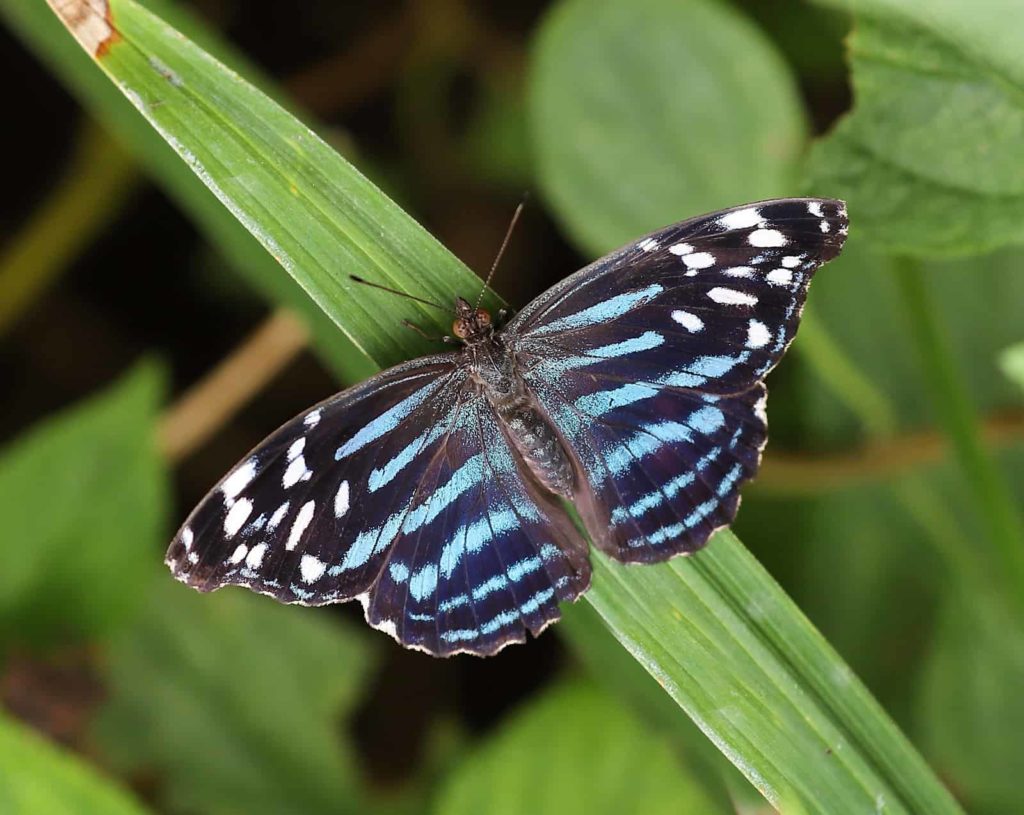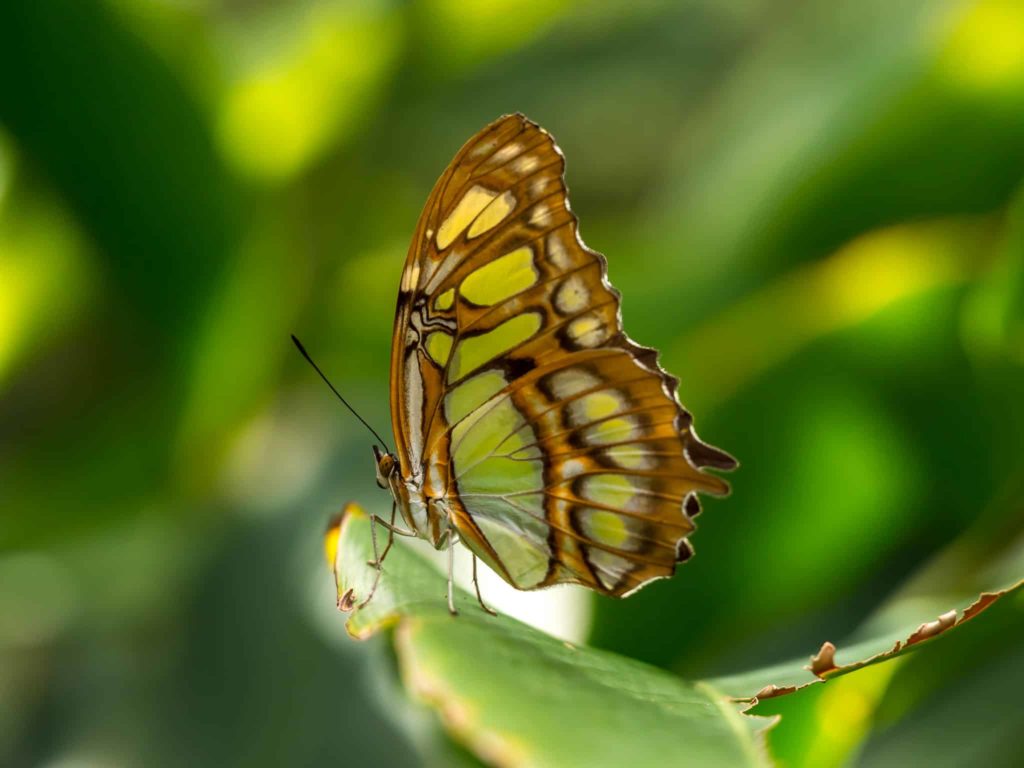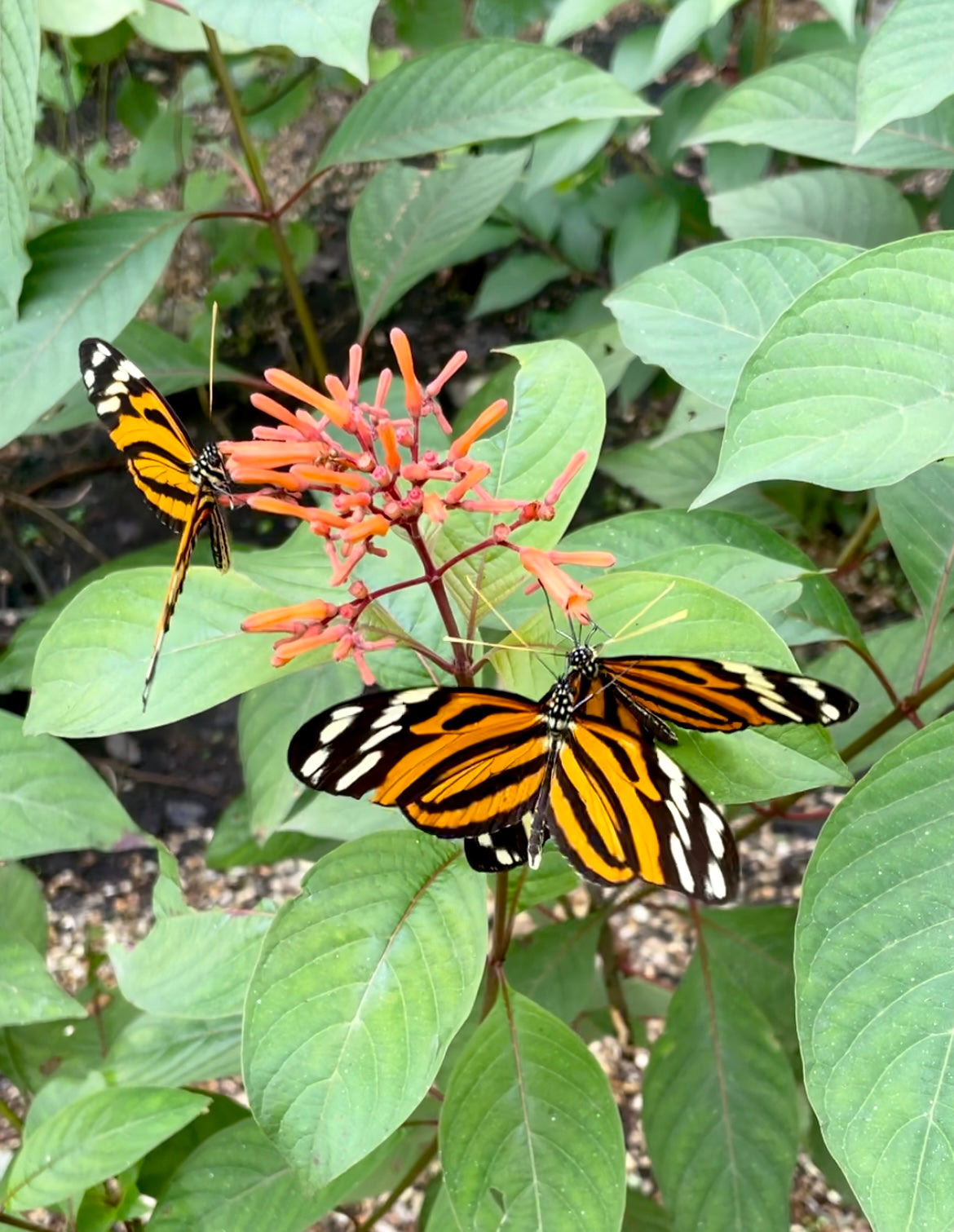Butterflies
-

Blue Morpho
Morpho helenor peleides
The blue morpho is among the largest butterflies in the world, with wings spanning from 5 - 7 inches. It will tease visitors with its stunning color in flight and are most likely to be found on over ripe fruit or in darker, secluded locations when at rest.
-

Mexican Bluewing
Myscelia ethusa
The wingspan is about 1 - 2 inches. More than likely you will see these basking on the sun, gently opening and closing their wings. Watch your step as the Mexican Bluewing is also fond of landing on the ground.
-

Banded King Shoemaker
Archaeoprepona demophone
The wingspan is about 4 - 4.5 inches. This fast flyer butterfly spends a fair amount of its time in the canopy of our flight area however it is also very likely to spend time on fruit closer to the ground and within an easy viewing distance.
-

Malachite
Siproeta stelenes
The wingspan is about 3 - 4.5 inches. The Malachite is a butterfly that is willing to show off for visitors, but on its own terms. Regularly seen feeding on fruits, flying high above or resting upside down on a leaf of a tree or tall bush.
-

Rusty-Tipped Page
Siproeta epaphus
The wingspan is about 2.5- 3.5 inches. They have a rapid fluttering and gliding flight, settling frequently to bask on low foliage or bare ground. Adults drink nectar from flowers like impatiens and lantana as well as juice from over ripe fruit.
-

Banded Peacock
Anartia fatima
The wingspan is aboout 2 - 2.5 inches. Despite being fairly dull compared to its cousins, this butterfly is just as friendly. It is one full of energy which moves frequently from flower to flower.
-

Crimson Patch
Chlosyne janais
The wingspan is about 1.5 - 2.5 inches. Despite its size, the crimson patch is easy to approach and observe close up. When feeding on a flower, they tend to walk around on the petals while opening and closing their wings.
-

Common Owl
Caligo memnon
The wingspan is about 5.4 - 6 inches. On an average day, the common owl can be found in one of two places, at rest in some shade spot or feeding on fruit. These butterflies are mostly active on cloudy days or at dusk or dawn.
-

Magnificent Owl
Caligo atreus
The wingspan is about 5.5 - 6.5inches. These butterflies are very active at dusk and dawn, but can also be seen flying about during the day. They can often be seen enjoying ripe banana. They often rest on a piece of wood or tree trunk.
-

Giant Owl
Caligo eurilochus
The wingspan is about 5.0 - 6.5 inches. These are another species of owl butterflies. They usually fly small distances at a time so as to give any potential predators a harder time spotting and following them. This butterfly is also most active at dusk, when there are predators hunting and when visibility is at its lowest.
-

Tiger Longwing
Heliconius ismenius
The wingspan is about 3-3.7 inches. The tiger longwing is a large longwing species and one that is not afraid to display itself. Flying at or above eye level, they will feed in the open as well as rest.
-

Isabella's Longwing
Eueides isabella
The wingspan is about 3 - 3.5 inches. Isabella's longwing is a bit more timid than other butterflies and has similar patterns as the tiger longwing. Fond of common nectars sources such as pentas, they are much easier to spot.
-

Golden Longwing
Heliconius hecale
The wingspan is about 3 - 4 inches. This species is unafraid to be out in the open, whether feeding, basking, resting or courting. They enjoy feeding at or above eye-level sight.
-

Small Postman
Heliconius erato
The wingspan is about 2 - 3 inches. A shy butterfly so keep an eye out for these butterflies in shadier locations where they like to rest.
-

Zebra Longwing
Heliconius charithonia
The wingspan is about 3 - 3.7 inches. A common butterfly which you can find at home. They enjoy venturing out into the open and sunny locations to feed.
-

Red Rim
Biblis hyperia
The wingspan is about 2 - 3 inches. This species will often display it's brilliant red hind wing borders. While at rest it is common to see them gently opening and closing their wings.
-

Ruby-spotted Swallowtail
Papilio anchisiades
The wingspan is about 4 - 4.5 inches. This swallowtail butterfly usually prefers to rest with its wings open but will usually close them when temperatures get cool. They enjoy sunny spots to find flowers and feed on their nectars.
-

Grecian Shoemaker
Catonephele numilia
Also know as the "stop light". The wiingspan is about 2.5 - 3 inches. When not fully at rest, it displays its wings regularly and is often easy to spot. When not active, the rely on its camouflaged underside on a tree trunk or plant foliage.
-

Glasswing
Greta oto
The wingspan is about 2 - 2.4 inches. The Glasswing is a dainty species of butterfly that is a joy and a marvel to behold. It is remarkable that the wings are largely transparent. Even without any color they make a remarkable sight.
-

Monarch
Danaus plexippus
The wing span is about 4 inches. Monarchs are famous for their seemingly impossible migration. Their flight is similar to it's cousin's the plain tiger and queen, in that the monarch glides about lazily, beating its wings a few times in between.
-

Queen
Danaus gilippus
A close relative of the Monarch. The wingspan is about 3 - 3.8 inches. The queen is easily approachable and seems to like a wide variety of flowers. They briefly hold their wings open while feeding.
-

Variable Cracker
Hamadryas feronia
The wingspan is about 2.5 - 3.5 inches. They get their odd name from the sound that males make as they chase away other males from their territory. They can be hard to approach unless they are feeding.
-

Mosaic
Colubura dirce
The wingspan: 2.75 - 3 inches. Also known as the "Street Map". The Mosaic takes its privacy very seriously, it usually hides on tree trunks in shaded places. They usually rest with their heads pointing to the ground in hopes that the odd shape of its wings will confuse predators.























